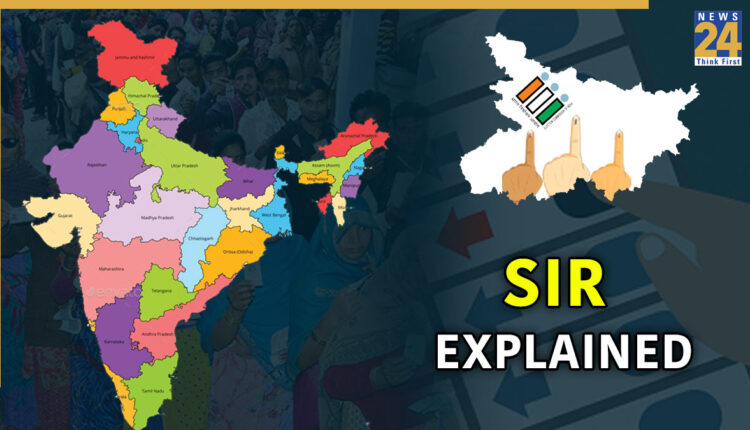What is Special Intensive Revision, Why It’s Conducted and How It Will Be Carried Out in 12 States News24 –
After the successful conduct of Special Intensive Revision (SIR) in Bihar, the Election Commission of India (ECI) on Monday, October 27, announced that the second phase of the SIR of electoral rolls would be now carried out in 12 States and Union Territories. The States/ UTs where the SIR will be conducted include: Andaman & Nicobar, Chhattisgarh, Goa, Gujarat, Kerala, Lakshadweep, Madhya Pradesh, Puducherry, Rajasthan, Tamil Nadu, Uttar Pradesh and West Bengal.
In this article, we will understand what SIR is, why it is conducted, why it is important, and how it will be carried out.
What is SIR and its Objectives?
The SIR is a large-scale, house-to-house verification drive conducted by the ECI to ensure the accuracy and integrity of electoral rolls. SIR’s objective is to produce an error-free voter list by ensuring that the names of all eligible citizens are included in the Electoral Roll (ER). It also has to make sure that no ineligible voter is included in the electoral rolls. While carrying this process, the ECI has to maintain complete transparency in the process of addition or deletion of electors in the electoral rolls.
Notably, the ECI, in exercise of its powers under Article 324 of the Constitution & Section 21 of the Representation of the People Act, 1950, can conduct SIR.
Why is SIR conducted?
There are several reasons for conducting the SIR of electoral rolls. According to the ECI, various reasons such as rapid urbanisation, frequent migration, young citizens becoming eligible to vote, non-reporting of deaths and inclusion of the names of foreign illegal immigrants have necessitated the conduct of an intensive revision so as to ensure integrity and preparation of error-free electoral rolls.
How It Will Be Carried Out in 12 States?
Addressing the press conference, Chief Election Commissioner Gyanesh Kumar stated that the voter lists of these regions will be frozen at 12 am tonight, after which all voters on those lists will receive Unique Enumeration Forms distributed by Booth Level Officers (BLOs). For SIR exercise, the Booth Level Officers (BLOs) are tasked with conducting house-to- house survey for verification. EROs/AEROs will print Unique Enumeration forms (EFs) for each elector as on 27th October, 2025. EFs will contain necessary details as contained in the current voter list.
Duties of BLOs:
Distribute the EFs to each existing Elector.
Help the Elector in matching/ linking with either their name or their relative’s name in last SIR held in 2002-2004.
For Matching/ Linking Electors/ BLOs can also access All-India database (https://voters.eci.gov.in/) of previous SIR.
Collect Form 6 & Declaration form for inclusion of new Elector and help in Matching/Linking.
Help the Elector fill in the EF, collect it and submit it to the ERO/AERO.
Make at least 3 Visits to the house of each Elector.
Electors can also fill the EF Online, particularly urban voters/temporary migrants.
Identify dead, permanently shifted and voters who are registered at more than one place.
Except the EF, No other document needs to be collected with EF during Enumeration Phase.
EROs/ AEROs will:
Include in the Draft Rolls, the names of all Electors whose Enumeration Forms are received.
Issue Notice to all those Electors whose names could not be matched/linked with last SIR.
Hear such cases for eligibility and decide on inclusion or exclusion of their names in Final Rolls
EROS/AEROs must ensure that:
No eligible citizen is left out and no ineligible person is included.
District Magistrates (DMs) will hear the first appeal against the decision of ERO Chief Electoral Officers will hear the 2nd Appeal against the decision of DMs.
Key Steps of SIR as per ECI
Pre-Enumeration Phase
Training of BLOs, EROs and DEOs.
Manual Matching/Linking with Last SIR by BLOs.
Computer Matching/ Linking with Last SIR by ECINET
Involvement of Political Parties
CEOs, DEOs and EROs to meet all Recognised Parties and explain the SIR process in full detail.
Training of Booth Level Agents (BLAs) appointed by all Recognised Political Parties.
BLAs can also collect duly filled in EFs from Electors, certify up to 50 EFs/Day and submit to BLO.
Enumeration Phase
Printing, Distribution, Matching/ Linking and Collection of duly filled in Enumeration Forms.
Rationalisation of Polling Stations with an upper limit of 1,200 voters.
Publication of Draft Electoral Rolls
Draft Rolls will contain all Electors whose Enumeration Form has been received.
List of Absent/Shifted/Death/Duplicate names not included in Draft Roll to be put on CEO website/public offices.
Issuance of Notices and taking a Decision thereon by EROs/AEROs
Notices will be issued for Electors who could not be matched linked with last SIR.
Verifying indicative documents to ascertain their eligibility as an Elector.
Hearing to ascertain their whereabouts prior to last SIR.
Receiving and Deciding on Claims & Objections by EROs/ AEROS
Any elector or BLA of recognised political parties can file a claim or objection.
Publication of Final Electoral Rolls.
Receiving and Deciding 1st Appeal by DMs and 2nd Appeal by CEO.
ECI SIR Schedule
| Activity | Dates |
|---|---|
| Printing / Training | 28th Oct – 3rd Nov 2025 |
| House-to-House Enumeration Phase | 4th Nov – 4th Dec 2025 |
| Publication of Draft Electoral Rolls | 9th Dec 2025 |
| Claims & Objection Period | 9th Dec 2025 – 8th Jan 2026 |
| Notice Phase (Hearing & Verification) | 9th Dec 2025 – 31st Jan 2026 |
| Publication of Final Electoral Rolls | 7th Feb 2026 |

